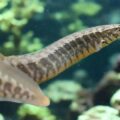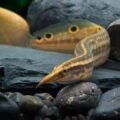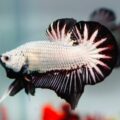Read this detailed guide before keeping an Electric Eel as a pet! We will share the special skills and safety measures needed for protecting yourself while handling Electrophorus electricus, and keeping this species happy and healthy in a home aquarium.

Electric Eel: Powerful, High-Voltage Giant
Electrophorus electricus is a large freshwater electric predator known for its size and other unique features. This species grows between 6 and 8 feet long and releases a shock of up to 600V.
Although it’s commonly called an electric eel, this Electrophorus electricus intro would show you that it’s not a true eel. Instead, this air-breathing, shocking aquarium fish is a knifefish.
In this electric eel overview, you’ll learn how to manage its electric organs while housed in a home aquarium and much more! Let’s get started with some details on its natural habitat.
Author’s Note: Check out our post on The 13 Freshwater Aquarium Eels That Can be Kept as Pets for even more eels!
Native Habitat & Adaptations
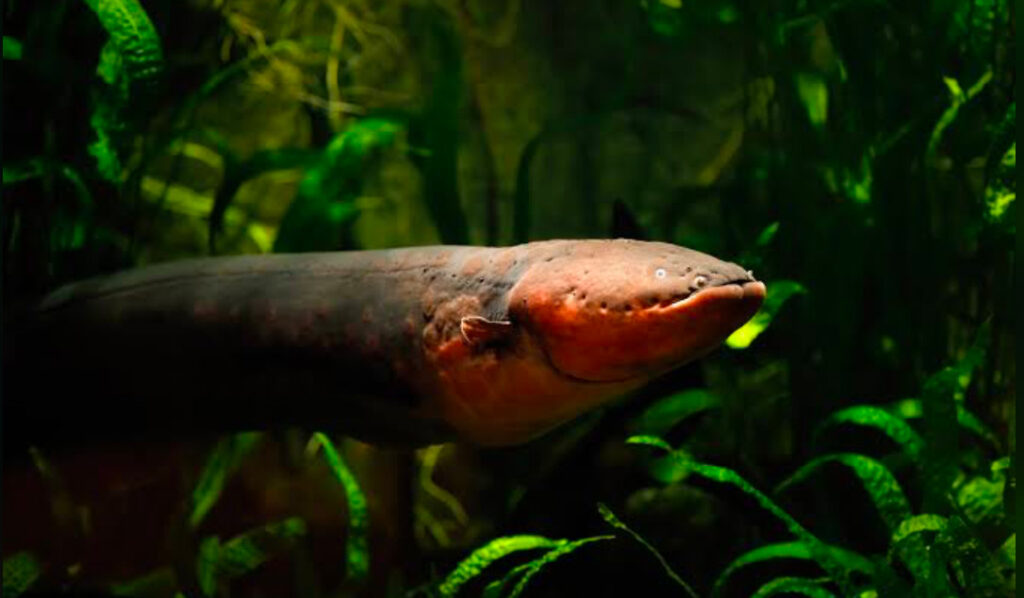
Electrophorus electricus is an Amazon basin predator found in the South American waters, particularly the Amazon & Orinoco muddy basins.
This South American river fish thrives in a strictly freshwater environment, whereas true eels survive in brackish waters.
Because of the muddy water in its wild environment, there are often low oxygen levels there. So, all electric eels need access to the surface for air due to these physical adaptations.
The most fascinating feature of the Electric Eel to aquatic enthusiasts is its electric shock. These shocks are multifunctional (more details later), however in short, as your pet glides through the waters it senses changes in electric fields and reacts accordingly.
Before we recreate an electric eel habitat for a large aquarium or pond, let’s discuss identification.
Identifying Features & Massive Size
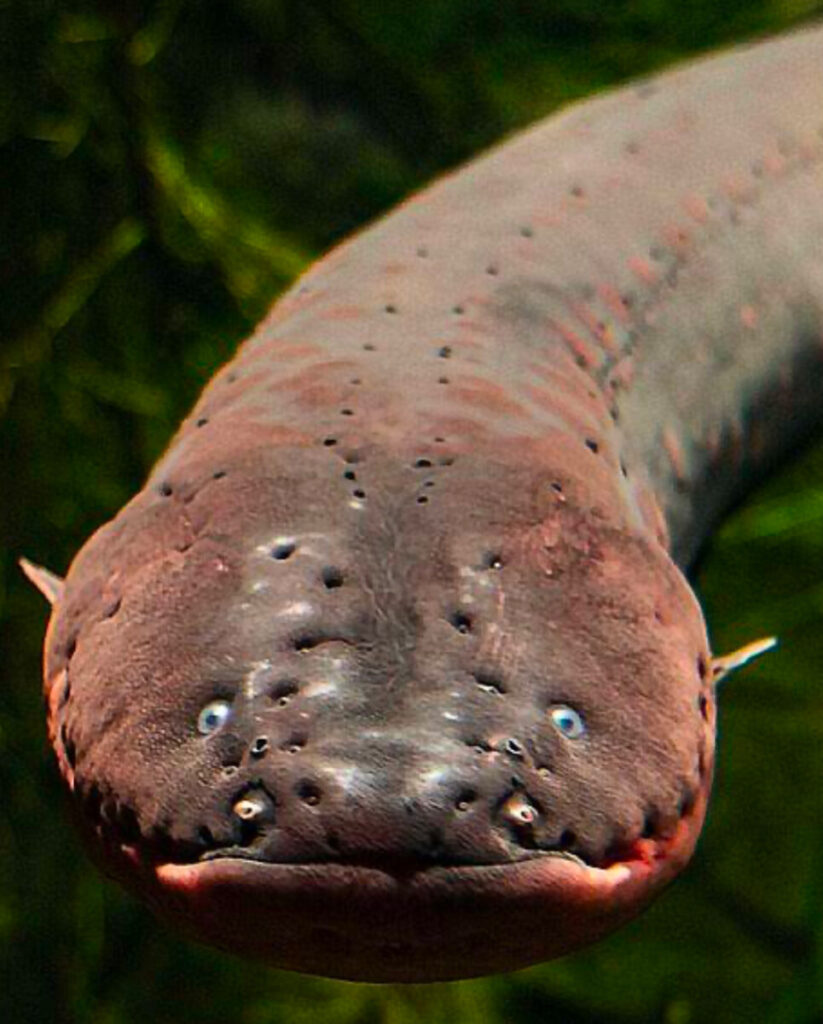
Because this species is a giant aquarium fish, identifying the electric eel is easy. It has a long, scaleless body that stretches at least 6ft with an average weight of 44lbs (20kg).
Its body color is often two-toned with dark olive on the upper body and orange or yellow underbellies. Although they are large freshwater fish, the electric eel has small pectoral fins, with an anal fin that stretches from its back to its tail tip.
Additionally, this species has three electric organs, a square head, and a vascularized respiratory system. That makes it an obligate air-breather, meaning the Electric Eel must swim to the surface for oxygen before submerging to the tank’s bottom, then repeat the cycle every couple of minutes.
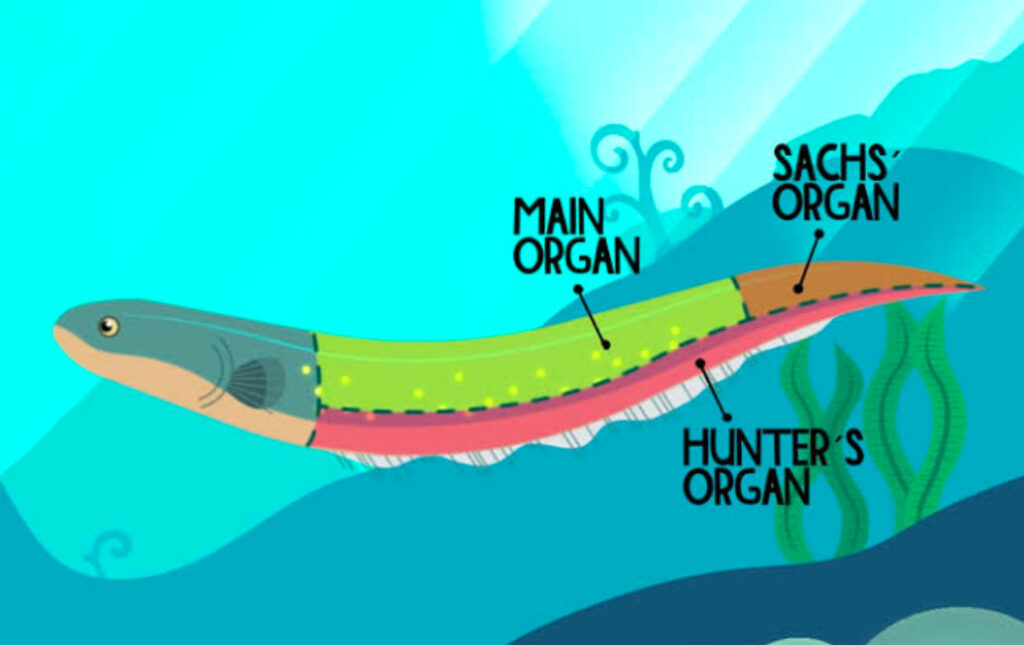
Its three electric organs and their functions are as follows:
| Main Organ | Largest Extends from head to tail in the back Generates voltage for shocking prey and predators |
| Hunter’s Organ | Second largest Parallel to the Main Organ Also generates voltage for shocking predators as a defense and prey for hunting |
| Sach’s Organ | Smallest Oriented towards the back upper part of the tail Generates a low-voltage pulse, primarily used for communication amongst other electric eels and navigation |
There’s a fourth organ, which is actually a collection of specialized cells called electrolytes. They power the Main and Hunter’s Organs due to their connection to the nervous system. When your electric eel swims across water and feels electric fields, it sends a message through the electrolytes to the shocking organs to either defend or hunt.
To accommodate these unique Electrophorus features, here’s an ideal tank or pond setup.
Tank Size & Setup Needs

The best tank for large eel species like Electrophorus electricus would hold at least 300 gallons of water. Use a rectangular container for your electric eel tank setup instead of a vertical one.
Whichever container you choose, your monster fish aquarium’s basic requirements remain the same.
- Provide an open swim space
- Secure the tank with a heavy lid
- Because the electric eel spends time at the bottom, use a soft sand substrate for the aquarium floor.
- Provide air access for their obligate air-breathing.
Building an escape-proof aquarium is necessary because electric eel species are jumpers! If you don’t secure them in the tank, they’ll try to escape.
Water Parameters & Filtration

Penn-Plax Cascade All-in-One Aquarium Canister Filter
Found On Amazon
Now, let’s discuss electric eel water conditions similar to the Orinoco River’s warmth.
- Temperature: 75 – 82°F
- pH level: 6 – 7.5
- Hardness: 1-12dGH
After setting ideal parameters for Electrophorus electricus, stabilization is your next step. To ensure a stable, warm-water system, set a low flow with high oxygen and consistent filtration. Because of their size, electric eels generate more waste than the average species.
So, install a high-powered, large fish filtration system that can perform mechanical, chemical, and biological functions. It would remove solid waste, dissolve pollutants, and complete the nitrogen cycle by converting ammonia to nitrite and then nitrate.
Diet & Feeding Regimen

You may wonder about the kind of predatory fish feeding routine that allows them to generate so much waste. Well, electric eels are carnivorous pets that eat only live food and animal matter.
Managing a large carnivorous fish diet in a controlled environment can be challenging because of the shocks. So, here are some tips on what to feed Electrophorus electricus and how to be careful.
Feed carnivorous fish foods such as,
- Fish fillets
- Shrimp
- Crabs
- Invertebrates
- Small fish
- Rats (occasionally)
Because electric eels are nocturnal hunters, use the following nighttime feeding tips to stimulate their natural behaviors,
- Wear rubber gloves when feeding them
- Use feeding tongs or tweezers to hold or deliver their food as you feed them
- Dim the lighting in the tank
- Try not to keep your hands in the water for too long to reduce the risk of shocks.
Compatibility & Tank Mates

Due to their shocking nature, it’s natural that the electric eel is a solitary monster fish species.
Its size is enough motivation to keep it alone. However, if you need more convincing, you can test the Electrophorus compatibility with other species. When you consider the shock risks and predatory behavior, you realize that non-species are incompatible electric eel tank mates.
Some aquarists recorded rare occasions where electric eels shared a tank with other large aquarium fish. Because these are exceptions to the rule, know that doing this is risky and requires careful planning and monitoring.
Also, note that a crucial part of predatory fish care is keeping them away from stressful environments like community tanks.
Health Risks & Handling

Because of their unique characteristics, you may face shock risks and more when handling large eels.
So, look out for yourself as a keeper, and care for this hardy fish because it’s sensitive to poor water conditions.
Follow precautions on safe handling for electric fish, like using insulated equipment for feeding, since metal conducts electricity.
Author’s Caution: Wear safety gloves when handling this fish to reduce the risk of drowning from muscle rigidity, respiratory issues, cardiac arrest, and other long-term health problems from shocks.
Lifespan & Keeper Commitment

If you didn’t know before now, it’s time to tell you that monster fish keeping would occupy your time for at least 15-20 years. When you provide the care recommended in this overview, your electric eel’s lifespan can even extend beyond 20 years.
So, it goes without saying that electric eels are an expert-level fish species.
You must consider the large tank power cost, including the filtration, lighting, oxygenator, heater, insulator, and every component working for its smooth running.
Prioritize safety planning in your long-term Electrophorus care schedule. Scroll up for details on tank setup and diet.
Conclusion: Should You Keep an Electric Eel?
You can agree that keeping electric eel fish is impressive but dangerous. Although it’s a challenge you can conquer, Electrophorus pet care isn’t ideal for beginners.
This advanced aquarist species demands considerable skill in every aspect, from constructing its tank setup to nighttime feeding and managing health risks for at least 15 years.
Don’t ignore the monster fish aquarium advice in this guide, especially the one about leaving this species for experienced handlers with specialized setups.
If you fit this criteria, good luck with your electric eel keeping adventure. Take us on this journey with you through the comment section below.





